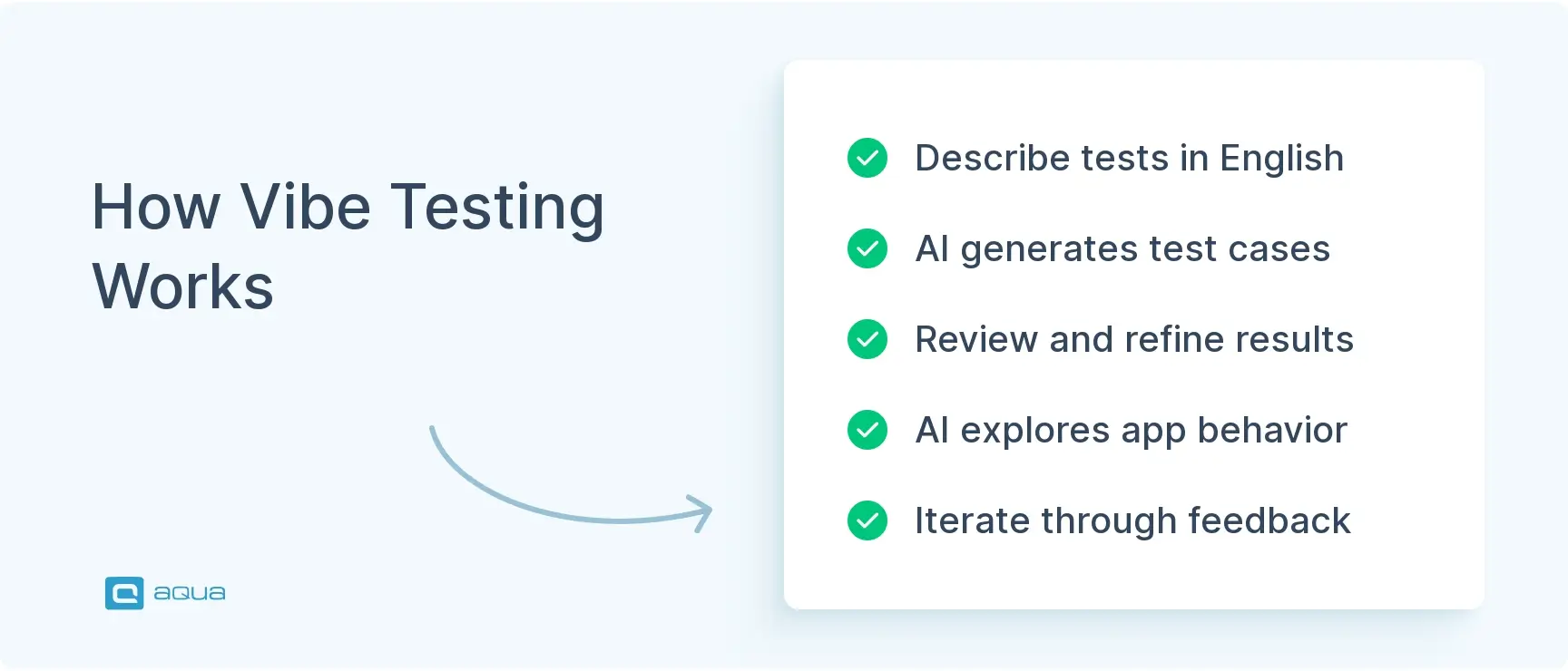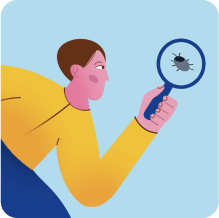Key Takeaways
- Vibe testing lets you create tests by describing what you want to check in plain English instead of writing test scripts – say “make sure users can’t checkout with empty carts” and the system builds the actual tests.
- Teams report cutting test creation time by 90% when moving from manual scripting to conversational test generation, with comprehensive edge case coverage that would take hours to script manually.
- Tests automatically adapt when developers change UI elements, eliminating the constant maintenance cycle of fixing broken selectors and updating test code that plagues traditional automation.
- Anyone on the team can contribute meaningful test scenarios regardless of coding ability – product managers describe user flows, designers validate workflows, all in natural language.
- The approach solves a critical problem in modern development: when AI writes your code, you need equally fast testing to verify it actually works for real users.
Vibe testing matches the speed of AI-assisted development, but the transition requires platforms that genuinely understand natural language. Here’s what actually works in practice 👇
What is Vibe Testing?
Vibe test is the QA counterpart to vibe coding. While vibe coding lets you build software by describing what you want in natural language, vibe testing lets you verify that software, using the same conversational approach.
Instead of writing detailed test scripts or following rigid test plans, you describe your testing intentions in natural language and AI converts those descriptions into executable tests. Think of it as having a conversation with an intelligent testing system that understands what you mean when you say “make sure users can’t check out with an empty cart” or “verify that only admin users see the delete button.”
Here’s what makes vibe testing different from traditional testing strategies:
- Conversational: You write test requirements in plain English instead of code
- Intent-focused: You describe what should happen, not how to test it step-by-step
- AI-assisted: The system generates test cases, scenarios, and even finds edge cases you didn’t think of
- Exploratory: Tests adapt and discover new scenarios based on actual application behavior
- Iterative: Quick cycles of describing, testing, reviewing, and refining
Traditionally, you create a detailed test plan and inspect every step to verify it functions as defined. With vibe testing, you simply tell the system “test login functionality” and it figures out the comprehensive testing approach. It includes valid credentials, invalid passwords, locked accounts, network timeouts, and edge cases you might have missed.
How Vibe Testing Works
Vibe testing operates through continuous conversation between you and AI testing tools. The process follows a simple but powerful pattern that mirrors how vibe coding works.
Start with Natural Language Descriptions
Instead of writing test scripts, you describe what you want to test: “Make sure users can reset their password” or “Verify that the shopping cart updates when items are added.” The AI interprets these requirements and generates appropriate test scenarios, including edge cases you might not have considered.
AI Generates and Executes Tests
The system understands your conversational commands and creates working tests that interact with your actual application. For example, when you say “test the checkout process,” it might generate scenarios for successful purchases, declined payments, inventory shortages, and network interruptions. All these happen without you having to script each case manually.
Continuous Refinement Through Feedback
When tests run, you review the results and provide feedback in natural language. “That test missed the mobile error message”, or “Also check what happens when someone uses a gift card.” The AI adjusts and improves the testing approach based on your input and creates a collaborative testing experience.
Exploratory Discovery
The AI doesn’t just follow your initial instructions. It also discovers additional test scenarios by exploring how your application actually behaves. It might notice that certain user actions trigger unexpected workflows, or that specific data combinations reveal interesting edge cases worth investigating further.

This approach eliminates many common ai-driven testing myths about AI replacing human testers. Instead, it amplifies human testing intuition with AI capabilities.
Benefits of Vibe Testing
Vibe testing solves the speed mismatch between modern AI-assisted development and traditional testing approaches. It brings testing into the same conversational, intent-driven workflow that makes vibe coding so effective.
Test Creation at the Speed of Thought
You can create comprehensive test suites as fast as you can describe what needs testing. Instead of spending hours writing and debugging test scripts, you spend minutes explaining what should work. The AI handles all the technical implementation while you focus on what actually matters for your users.
Realistic User Behavior Testing
The AI explores your application like real users do, finding scenarios you might never have scripted manually. It doesn’t just follow predetermined paths, it discovers how different features interact and what happens when users behave unpredictably.
Self-Healing and Adaptive Tests
When your application changes, vibe testing adapts automatically. You don’t spend time fixing broken selectors or updating test scripts when developers change the interface. The system understands the intent behind tests and adjusts to match updated functionality.
Democratized Testing
Anyone who understands your application can contribute to testing, regardless of their coding skills. Product managers can describe user scenarios, designers can validate workflows, and developers can quickly verify their changes, all using natural language rather than technical test scripts.
Continuous Quality Validation
Vibe testing provides the critical checkpoint in AI-assisted development, verifying that generated code actually works as intended. When AI writes your application logic, vibe testing ensures that logic produces the right results for real users in real scenarios.
The difference isn’t that your app suddenly has more features – it’s that using those features feels more pleasant and intuitive.
As you explore the concept of vibe testing, you might be wondering how to implement this intuition-driven approach within your existing QA framework. This is where a modern test management platform like aqua cloud becomes invaluable. aqua’s AI Copilot can transform your intuitive testing ideas into structured test cases in seconds, allowing you to capture that “it just feels right” factor without sacrificing documentation or traceability. When a tester has a gut feeling about potential issues, they can quickly articulate it through aqua’s AI-powered interface, which then generates comprehensive test scenarios that might otherwise be overlooked in traditional testing approaches. The platform seamlessly bridges the gap between exploratory intuition and structured QA, enabling teams to document and share those important “vibe” observations that often make the difference between functional software and truly exceptional user experiences. Aqua’s integrations with frameworks like Jira, Confluence, Azure DevOps will turn your testing efforts into a superpower, while Capture bug reporting integration makes it easy to document those hard-to-describe moments when something just feels wrong – complete with screenshots, user context, and team collaboration tools to help you communicate vibe issues effectively.
Translate your testing intuition into actionable test cases in seconds with aqua cloud
Vibe Testing Challenges and Limitations
Despite its advantages, vibe testing comes with real challenges that teams need to understand before adoption.
AI Understanding Limitations
AI systems don’t always interpret your testing intentions correctly. When you say “test the checkout process,” the AI might miss edge cases that seem obvious to you, or focus on scenarios that aren’t actually important for your business. The quality of generated tests depends heavily on how clearly you communicate your requirements.
Quality and Reliability Concerns
Generated tests might look comprehensive but miss critical validation steps. The AI might create tests that pass consistently but don’t actually verify the important behaviors your users depend on. Human oversight remains essential to ensure tests validate meaningful functionality.
Learning Curve and Tool Maturity
Current vibe testing tools are still evolving, and teams need to learn new workflows and approaches. The ecosystem is fragmented, requiring experimentation to find what works for your specific needs. Integration between different AI testing tools can be challenging.
Context and Domain Knowledge Gaps
AI systems lack a deep understanding of your business context and user needs. They might generate technically correct tests that miss the nuanced behaviors that make your application valuable to users. Complex business rules and domain-specific requirements often need human interpretation.
Integration with Existing Workflows
Moving from traditional testing to vibe testing requires changes in how your team works, reports on quality, and maintains test suites. The transition can be disruptive, especially for teams with established testing processes and test automation tools.
Tools for Vibe Testing
Several platforms now support vibe testing approaches, each with different strengths and focus areas.
AI-Powered Test Generation Platforms
aqua cloud offers natural language, AI-powered test creation where you describe test scenarios in plain English and the platform generates executable tests. Its AI-powered interface aligns perfectly with the intent-first, prompt-driven philosophy of vibe testing.
Vibe testing represents a powerful evolution in quality assurance: one that acknowledges the human element of software interaction. But to truly maximise its potential, you need tools that support both intuition and structure. aqua cloud offers the perfect blend of AI-powered assistance and comprehensive test management to make vibe testing a practical reality for your team. With aqua’s AI Copilot, you can instantly convert loosely defined ideas or gut feelings into actionable test scenarios, ensuring nothing gets lost in translation. With Aqua’s RUG-AI, you can train an AI on your own data: documents, videos, knowledge base, even tickets, in minutes. The result: test assets with unmatched precision and quality. The platform’s collaborative features capture qualitative feedback alongside functional results, while customisable dashboards visualize both the technical and experiential aspects of your testing efforts. By centralizing all your testing activities from rigid functional checks to intuitive vibe assessments, aqua helps your team deliver software that doesn’t just work correctly but genuinely resonates with users on an emotional level.
Turn intuition-driven testing into measurable quality improvements with aqua cloud
Appvance AIQ focuses on learning-based test generation that explores applications automatically and creates tests based on discovered behaviors. The platform’s AI script generation capability actively learns applications through deep exploration, clicking and navigating like real users.
TestRigor emphasizes plain English test creation and maintenance, allowing teams to write tests in natural language that the platform converts to executable automation without requiring coding expertise.
AI-Assisted Development Integration
Playwright with AI enables vibe testing through conversational interfaces and Model Context Protocol integration. You can describe testing requirements and have AI generate Playwright test code automatically, bridging the gap between natural language intent and technical implementation.
GitHub Copilot integration helps generate test cases and scenarios based on code context and natural language descriptions within your existing development environment, making vibe testing accessible within familiar workflows.
Conversational Testing Platforms
TestZeus Hercules provides AI agents that handle test case generation, execution, and debugging based on conversational inputs. The platform focuses on making testing keep pace with AI-assisted development by handling routine testing work automatically.
You need to start simple. Many teams begin by using AI assistants like ChatGPT or Claude to help generate test cases, then gradually adopt more sophisticated tools like aqua’s AI Copilot as their comfort level increases.
I feel like vibe testing is much more beneficial than vibe coding. Bad code is often worse than no code, but bad tests are better than no tests. I also feel like pasting in a snippet and asking chatGPT for some unit tests is sort of the thing it's best at.
Getting Started with Vibe Testing
Moving to vibe testing doesn’t require throwing away your existing testing practices. Start by augmenting your current approach with AI-assisted test generation.
Begin with Test Case Generation
Use AI to help create test scenarios from your existing requirements and user stories. Instead of manually brainstorming edge cases, describe your feature functionality and let AI suggest comprehensive test scenarios you might have missed.
Practice Natural Language Test Descriptions
Start writing test requirements in plain English rather than technical specifications. Instead of “verify HTTP 200 response when POST request sent to /api/login with valid credentials,” write “confirm users can log in with correct username and password.” This prepares you for tools that accept natural language input, like aqua cloud.
Experiment with AI-Assisted Debugging
When tests fail, try describing the problem to AI assistants and asking for suggestions. This helps you get comfortable with conversational troubleshooting approaches and builds confidence in AI collaboration for testing tasks.
Integrate Gradually with Existing Tools
Many established testing frameworks now have AI integrations. Start by adding AI-powered features to your current Selenium, Cypress, or Playwright setups rather than switching to entirely new platforms. Aqua smoothly integrates you with all of these frameworks.
Build Team Comfort with AI Collaboration
Help your team understand that vibe testing augments their expertise rather than replacing it. The goal is to handle routine work automatically so humans can focus on complex testing scenarios that require domain knowledge and creativity.
Set Clear Quality Gates
Establish criteria for when AI-generated tests are ready for production use. Human review remains essential for ensuring tests actually validate meaningful functionality and cover the business-critical scenarios that matter most to your users.
Conclusion
Vibe testing represents the natural evolution of software testing in an AI-driven development world. As code generation becomes conversational and intuitive, testing needs to keep pace with the same approach. The goal isn’t to eliminate human testers but to free them from repetitive test scripting so they can focus on strategic quality decisions, complex user scenarios, and business-critical validations that require human insight. If you adopt vibe testing now, you are positioning yourself for a future where testing speed matches development speed, and quality assurance becomes as conversational and AI-assisted as coding itself.

















